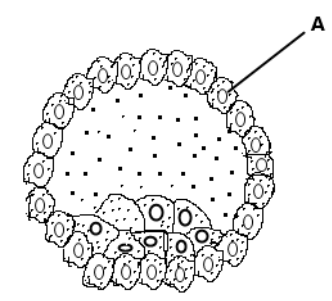
Identify the figure given below and the part labelled “A”.


Answer
555.9k+ views
Hint:This structure is formed in the early development of mammals. This name comes from the Greek word which means a sprout.
Complete answer:
The Morula cells begin cell differentiation during human embryonic development approximately five to seven days after fertilisation and the morula changes to the Blastocyst. In the uterus, the zona pellucida around the blastocyst splits and enables the uterine wall to be inserted around 6 days after fertilisation. Implantation signals the conclusion of the embryogenesis germinal process. Early development by human implantation of the embryo from ovulation. The process of blastocyst occurs between 5-9 design days. By mitosis, the zygote grows and becomes known as the morula if it formed into 16 cells. All cells are autonomous and not fatally defined until this stage of development. The morula then grows into the blastula in many species through cavitation. Cells that cover blastocoel and inner cell mass (embryoblast), then produce cell division to form the cells of blastula into two cells. The idea is then referred to as the blastocyst.
The given diagram is a blastocyst and A is trophoblast. The blastula cells are distinguished into two cell layers, both inside and out. The external cells form the trophoblast which later forms and helps to enforce the placental cord. The cell mass forms the embryo that grows. The intermediate cavity is called blastocoel.
Note:In the early development of mammals, the blastocyst is a structure. It has an internal cell mass (ICM) that then forms the embryo. The exterior layer of the blastocyst is made up of the cells called the trophoblast collectively. The inner cell mass and a fluid-filled cavity called the blastocoel are covered by this layer. The placenta comes from the trophoblast.
Complete answer:
The Morula cells begin cell differentiation during human embryonic development approximately five to seven days after fertilisation and the morula changes to the Blastocyst. In the uterus, the zona pellucida around the blastocyst splits and enables the uterine wall to be inserted around 6 days after fertilisation. Implantation signals the conclusion of the embryogenesis germinal process. Early development by human implantation of the embryo from ovulation. The process of blastocyst occurs between 5-9 design days. By mitosis, the zygote grows and becomes known as the morula if it formed into 16 cells. All cells are autonomous and not fatally defined until this stage of development. The morula then grows into the blastula in many species through cavitation. Cells that cover blastocoel and inner cell mass (embryoblast), then produce cell division to form the cells of blastula into two cells. The idea is then referred to as the blastocyst.
The given diagram is a blastocyst and A is trophoblast. The blastula cells are distinguished into two cell layers, both inside and out. The external cells form the trophoblast which later forms and helps to enforce the placental cord. The cell mass forms the embryo that grows. The intermediate cavity is called blastocoel.
Note:In the early development of mammals, the blastocyst is a structure. It has an internal cell mass (ICM) that then forms the embryo. The exterior layer of the blastocyst is made up of the cells called the trophoblast collectively. The inner cell mass and a fluid-filled cavity called the blastocoel are covered by this layer. The placenta comes from the trophoblast.
Recently Updated Pages
Why are manures considered better than fertilizers class 11 biology CBSE

Find the coordinates of the midpoint of the line segment class 11 maths CBSE

Distinguish between static friction limiting friction class 11 physics CBSE

The Chairman of the constituent Assembly was A Jawaharlal class 11 social science CBSE

The first National Commission on Labour NCL submitted class 11 social science CBSE

Number of all subshell of n + l 7 is A 4 B 5 C 6 D class 11 chemistry CBSE

Trending doubts
What is meant by exothermic and endothermic reactions class 11 chemistry CBSE

10 examples of friction in our daily life

One Metric ton is equal to kg A 10000 B 1000 C 100 class 11 physics CBSE

1 Quintal is equal to a 110 kg b 10 kg c 100kg d 1000 class 11 physics CBSE

Difference Between Prokaryotic Cells and Eukaryotic Cells

What are Quantum numbers Explain the quantum number class 11 chemistry CBSE




